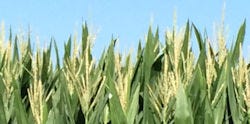
Whether it pays to apply foliar fungicide is never a slam-dunk answer. Buyers have to weigh a variety of factors in any given year to determine whether the investment will pay in higher yields.
Typically, the decision comes down to four factors, which DuPont Pioneer does a nice job of summarizing in its “Corn fungicide decision guide for foliar diseases.”

Managing fungicide applications is key to boosting crop yield, and managing input costs.
Managing fungicide applications is key to boosting crop yield, and managing input costs.Agronomists with the company recommend farmers scout for foliar diseases in corn such as Northern Leaf Blight and Gray Leaf Spot just before tassel emergence and answer the following questions when considering an application of foliar fungicide:
1-What was the previous crop?
Many foliar pathogens survive in corn residue, so the risk of foliar diseases (such as gray leaf spot and northern leaf blight) increases when corn is planted into a field that was corn the previous year.
2-What has the weather been like?
Rainy and/or humid weather is most favorable to foliar diseases. In growing seasons when these conditions prevail, the risk for disease development increases.
3-Does the field have a history of disease?
Some field locations may have a history of greater foliar disease severity. Fields in river bottoms or low areas or surrounded by trees may be more prone to having foliar corn diseases.
4-What is the resistance level of the hybrid?
If the disease resistance rating is a 6 or greater, a fungicide application may not provide a benefit.
For susceptible products (rating less than 4), spray if disease symptoms are present on the third leaf below the ear or higher on 50% of the plants examined.
For intermediate products (disease rating of 5), spray if these conditions apply:
• disease symptoms are present on the third leaf below the ear or higher on 50% of the plants examined the field is in an area with a history of foliar disease problems
• the previous crop was corn
• there is 35% or more surface residue, and
• the weather is warm and humid
About the Author(s)
You May Also Like






